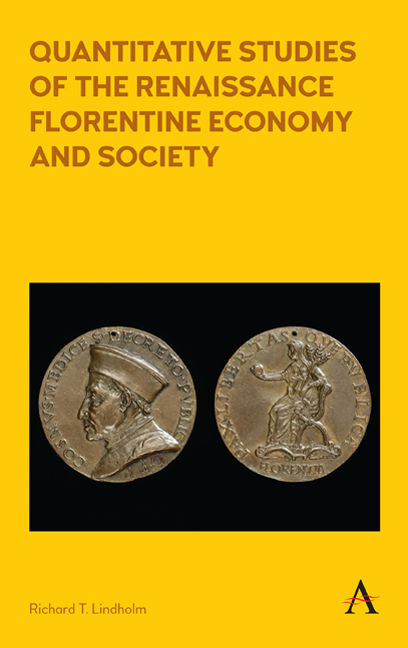Book contents
- Frontmatter
- Dedication
- Contents
- List of Illustrations
- Preface
- Acknowledgments
- List of Abbreviations
- Introduction
- Part I RISKS AND RETURNS
- Part II SOCIETY
- Chapter Three The Chances of Getting Rich in Renaissance Florence: The Wool Industry Occupational Wealth Hierarchy
- Chapter Four Palaces and Workers: Neighborhood Residential Segregation in Renaissance Florence
- Chapter Five The “State” Makes a Work of Art: The Impact of the Catasto Homeowner Tax Loophole on the Quattrocento Florentine Palazzo Building Boom
- Chapter Six Not Getting Ahead in Life: The Lack of Life-Cycle Wealth Accumulation in Quattrocento Tuscany
- Part III WORK
- Conclusion
- Glossary
- Bibliography
- Index
Chapter Four - Palaces and Workers: Neighborhood Residential Segregation in Renaissance Florence
from Part II - SOCIETY
Published online by Cambridge University Press: 10 January 2018
- Frontmatter
- Dedication
- Contents
- List of Illustrations
- Preface
- Acknowledgments
- List of Abbreviations
- Introduction
- Part I RISKS AND RETURNS
- Part II SOCIETY
- Chapter Three The Chances of Getting Rich in Renaissance Florence: The Wool Industry Occupational Wealth Hierarchy
- Chapter Four Palaces and Workers: Neighborhood Residential Segregation in Renaissance Florence
- Chapter Five The “State” Makes a Work of Art: The Impact of the Catasto Homeowner Tax Loophole on the Quattrocento Florentine Palazzo Building Boom
- Chapter Six Not Getting Ahead in Life: The Lack of Life-Cycle Wealth Accumulation in Quattrocento Tuscany
- Part III WORK
- Conclusion
- Glossary
- Bibliography
- Index
Summary
Introduction
When Leonardo Bruni extolled the virtues of Florence at the beginning of the Quattrocento, he was expressing the Renaissance ideal of neighborhood equality. The egalitarianism that is now widely associated with modernity was welcomed by many Renaissance writers. Jacob Burckhardt follows their lead and asserts that Florence achieved, or at least approached, this ideal. Critics argue that the Renaissance was more closely associated with inegalitarian developments that eroded the rights of the lower levels of society. They claim that the emergence of the Renaissance during the period from the Trecento to the Quattrocento engendered increasing societal divisions in both wealth and status. They also identify a variety of forms and channels of increasing inequality in Florence and its domains, including the increasingly inegalitarian distribution of wealth, a steady advance and eventual triumph of feudal values over republican values within the city, the exploitation of the countryside and the effects of currency debasement on the poor. Such critics associate this growing social division with a growing physical segregation by neighborhoods created through urban renewal and palace building. The well-integrated and heterogeneous Trecento medieval neighborhoods were thereby converted into segregated and homogeneous Quattrocento Renaissance neighborhoods.
This study tests the neighborhood segregation theory, which is composed of three closely linked and testable hypotheses: (1) neighborhoods were segregated, (2) core neighborhood residents had higher status during the Quattrocento and (3) segregation increased after the Trecento. A failure of any one of these three hypotheses would cast doubt on the segregation theory. The study presented here shows that none of these is supported by the evidence.
The remainder of this chapter presents the analysis of Florentine neighborhood segregation. It covers the general theories used to understand premodern urban ecology, including the Burgess Chicago School and Sjoberg models of urban ecology along with the notions of core and periphery and the segregation of neighborhoods. Next, evidence from other locations and times and the historiography of Florentine urban ecology are reviewed in order to provide some context. The key theme concerns whether Florentine neighborhoods were integrated or segregated, whether there was a general separation between core and periphery and whether the level of segregation increased. Finally, these hypotheses are tested, with the result being that all three of them are thoroughly rejected.
- Type
- Chapter
- Information
- Publisher: Anthem PressPrint publication year: 2017



